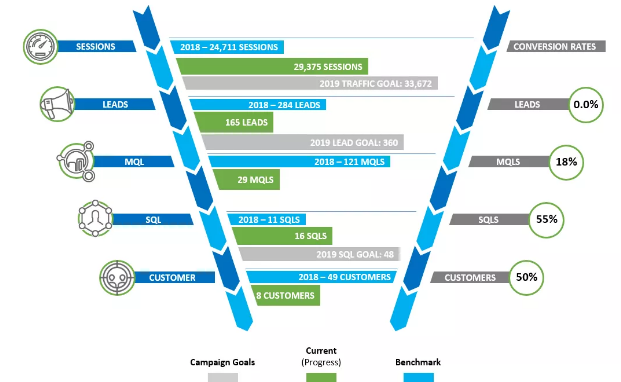
If you’ve attended HubSpot’s INBOUND19 event this September in Boston, you’ve seen plenty of keynotes and sessions that talk about how to #GrowBetter, remove friction in your sales process, add value to your customers, and generate meaningful results.
Everything in today’s digital marketing world evolves fast and furiously. Your strategy that worked well just 8 months ago, may no longer bring in the desired results you had counted on.
Strategic planning has evolved a lot since it became prominent in corporations back in the 1960s. Successful Digital Marketing Agencies today have to stay on top of the ever-changing technology landscape and adapt quickly so that they know how to best solve for their diverse customer base.
How Do You Start Your Strategic Planning Efforts?
A successful Strategy involves goal setting, determining ways and actions to achieve these goals, and allocating the right resources to execute. Strategic planning has to rely heavily on global performance metrics tracking such as website traffic sessions, lead goals, marketing-qualified leads, sales-qualified leads or customer acquisition. It is also important to take inventory of assets within the buyer’s journey such as
- an eBook resource for your Middle Of The Funnel for Persona A
- a relevant Success Story for Persona B about ready to make a decision (Bottom Of The Funnel)
As you start your strategic planning, you may want to ask yourself the following questions:
Question 1) How are we tracking towards big-picture goals for ourselves?
This funnel graphic here provides a quick visual of your various goals ranging from website traffic sessions all the way down to customer acquisition.
- The light blue bar showcases your data achievements for 2018.
- The gray bar outlines the actual agreed-upon 2019 goal
- The green bar highlights how you're currently tracking towards your 2019 annual goal.

Question 2) Does your buyer’s journey have any asset gaps?
Ideally, you should already have created buyer personas, which are a semi-fictional representation of your client's ideal customer based on market research as well as data pertaining to existing customers such as demographics, behaviors, and motivators.
Keeping track of the various assets you have in your inventory pertaining to the various stages in your audience's journey from initial awareness through delight is crucial. A case study that may have moved the needle just 2 years ago may be outdated today, maybe the product has been updated or a success story is no longer relevant as it focuses on outdated technology. You may have also focused on Top Of The Funnel content and find yourself having to create assets for anyone that moved into the Middle Of The Funnel.

How Do We Add Value to Client Organizations?
Any Strategic Plan needs to identify what specific and targeted activities will help us create success for the desired Return On Investment (ROI). We need to understand the BIG IDEA first, then figure out the specifics to achieve results.
1) Key Performance Indicator (KPI) driven growth campaigns
We talked about the importance of tracking towards big-picture goals. Planning strategically for a growth campaign it's important to do your homework and work on the following items:
- Dig into your client’s global metrics and identify areas of improvements to help track towards specific annual goals.
- In order to connect these to bottom-line results, you'll need to develop a strategic plan that effectively produces key short-term results over the course of a 6-month period of time.
- Your strategic recommendations should be based on proposed targeted key events or specific types of buyer personas.
- Front-loading any needed asset creation at the beginning will help you launch your strategic plan cohesively after that build phase ensuring you gain quick momentum right out of the gate.
- Upon execution, you're able to focus on optimizing the campaign by analyzing the respective KPI’s and making any tactical updates as needed.
- A couple of weeks before the campaign end, you can measure the various elements and efforts you had included in your strategic plan and take away important learnings, creature your analytics report and use those takeaways for your next strategic planning session.

2) Systems-driven projects in support of KPI-driven campaigns
As noted earlier, your Strategic Planning needs to include determining any gaps you have pertaining to the buyer's journey. Besides the need to create additional content, your audit may reveal the need for additional systems-related activities (integrations, website rebuilds, etc.) to aid the overall campaign objective.
Here's a helpful graphic to illustrate 4 crucial steps from mapping out your initial build to ongoing maintenance and enhancement opportunities.

3) Ongoing System Support
Your strategic planning further needs to include any support activities meant to maintain the effectiveness of the overall big picture growth strategy to achieve the desired ROI. Failing to account for any support blocks needed to keep the growth momentum going may derail your carefully architectured strategic plan leading not only to your personal frustration, a disappointed team but most importantly an unhappy client.
In summary, in today's fast-moving world, Strategic Planning has to focus on bite-sized achievable KPI-driven growth campaigns supported by system-driven projects and proactively determined support blocks. Keeping the growth momentum going without having to deal with unforeseen distractions allows us to focus on ROI.

